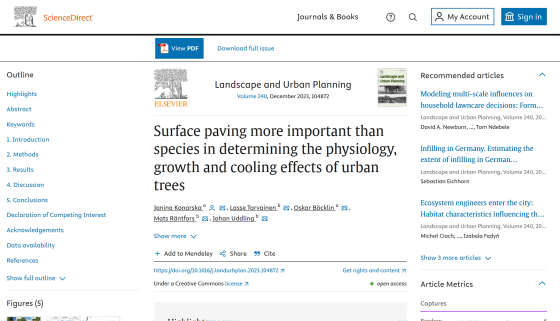Research results show that trees in urban areas grow poorly when the surrounding roads are paved

Trees planted in urban areas provide residents with a sense of nature, and studies have shown that areas with more street trees
Surface paving more important than species in determining the physiology, growth and cooling effects of urban trees - ScienceDirect
https://www.sciencedirect.com/science/article/pii/S0169204623001913

Less asphalt gives stronger trees in urban areas | EurekAlert!
https://www.eurekalert.org/news-releases/1010112
More grass, less asphalt. The best recipe for trees to provide ecosystem services
https://www.zmescience.com/science/more-grass-less-asphalt-the-best-recipe-for-trees-to-provide-ecosystem-services/
The various effects of trees planted in cities depend on the size and density of the tree canopy, and poorly grown trees will not be able to enjoy the maximum benefits. Therefore, it is important not only to promote greening by planting trees in urban areas, but also to create the conditions for trees to grow larger.
The research team points out that one of the main stress factors limiting tree growth in cities is ``road pavement.'' Paved surfaces around trees, such as asphalt, prevent rainwater from penetrating into the soil, reducing the amount of water and nutrients the tree can absorb. In addition, paved ground increases the temperature of the atmosphere, ground surface, and soil, and also reduces soil aeration, which may impede root development. However, until now, there has been limited research linking the growth of street trees and road pavement.
The research team investigated the effects of road pavement on street trees such as red oak , horse chestnut , and linden in multiple regions of Gothenburg and Mälndal , Sweden. The Japanese linden grows naturally in most parts of Europe, and the American oak and horse chestnut are common street trees in Sweden.

The study was based on a variety of parameters, including canopy density, tree growth, and the amount of water released through leaves through
The analysis revealed that 20 to 30-year-old street trees surrounded by grass are on average 2.6 m taller and have 1.3 m wider canopies than street trees with paved surfaces. Did. Furthermore, the density of the tree canopy is 61% higher, and the cooling effect is twice as strong.
The impact of the difficulty in water reaching the roots differs depending on the type of tree, and the horse chestnut tree was the least affected by the paved road surface. However, when the road surface conditions are good, the cooling effect of the atmosphere seems to be inferior to that of American oak and Japanese linden, so it seems that not all horse chestnuts should be planted.
Janina Konorska from the University of Gothenburg, lead author of the paper, said: 'Our study shows that the amount of paving surrounding a tree is an important factor. The air above the asphalt is If the surface is warmer and harder than the top of the soil, rainwater will not reach the roots, and this will affect the growth of the tree.'

Related Posts:
in Science, Posted by log1h_ik







